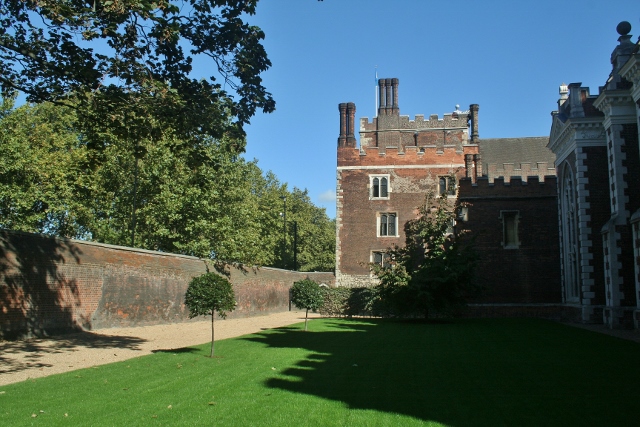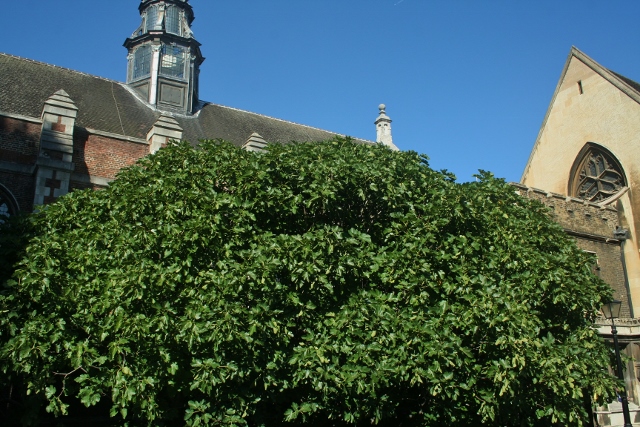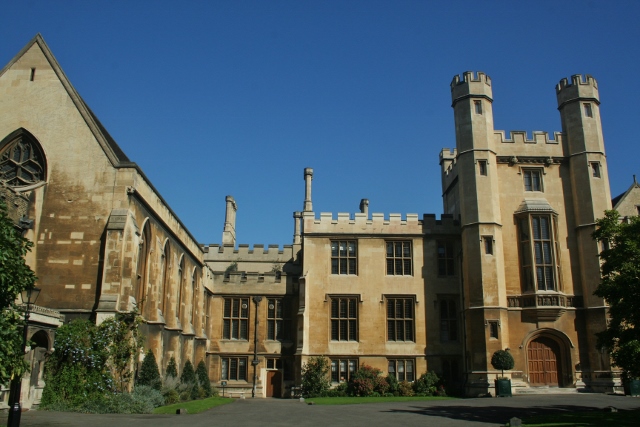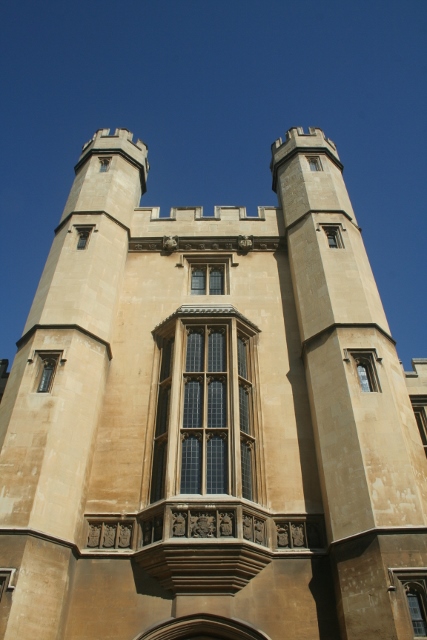Lambeth Palace
Lambeth Palace, the London home of the Archbishop of Canterbury, is on the south bank of the Thames, just off Lambeth Bridge. Whilst its location could lead one to believe that the orientation along the riverside is east-west, in fact, the river is actually running north-south at that point – a fact not realised until you are in the Chapel and see the altar at the east end. This means Westminster is to the west, and slightly north.
The main entrance to the palace is not huge, and may be easily missed as the London traffic hurtles along, but once inside the Tudor diapered red brick walls, the palace and gardens are a haven of tranquillity. On our visit, the palace was taking part in the Open House scheme so an extra room was accessible, not available in the usual tours.
The entrance is an archway under a 15th century tower, known as Morton’s Tower as it was constructed by Cardinal-Archbishop John Morton (Abp from 1486) in the 1490s. There is a lovely stone fan vaulted ceiling.
Through the arch, across a small green, is the Lollards’ Tower. The name of the tower is taken from the fact that ecclesiastical prisoners were held here in an attempt to make them recant their ‘heresy’. The Lollards flourished in the late 14th to early 15th centuries, but were driven underground by persecution.

To the right of the grass lawn is the Great Hall. Another archway leads east under the Great Hall into an enormous quadrangle. On the north side of the quadrangle is a marvellous 19th century ‘gothick’ construction in golden Bath stone which forms the main entrance and living quarters of the Archbishop and his family. This wing was designed by the architect Edward Blore (1787 – 1879) who also worked on Buckingham Palace, Peterborough Cathedral, and Government House, Sydney. His work was commissioned by Archbishop William Howley (Abp from1828).
Sadly, for the Tudor aficionado, much of what was left of the original mediaeval and Tudor buildings (following the depredations of the Civil War) were knocked down. Nevertheless, the result is very pleasing.On the west range of the quadrangle, immediately in front of east flank of the Great Hall, is the enormous white fig, a descendant of one first planted in the 1550s by Cardinal-Archbishop Reginald Pole (Abp from 1556. Pole had been an exile in Italy since the 1530s, and brought the original plant with him to remind him of sunnier climes when he returned as Archbishop).

Entrance to the palace is through a door in the west range which takes you through a modern space into an atrium built for the Millennium celebrations. It carefully echoes the stone of the original walls, without being a pastiche. From the atrium you can see into the crypt chapel. The oldest part of the palace, it dates from the late 11th century.
It was filled with rubble within a hundred years of its construction to alleviate flooding (before embankment in the 1860s, the Thames reached up almost to the palace gates, and travel to and from Westminster or London was by ferry.) When the rubble was cleared in the early 1900s the crypt remained in all its eleventh century purity, its arched vaults springing from pillars of Purbeck marble. It is used daily for worship.
Up a flight of stairs and along a walkway overlooking the atrium, the visit continues up a stone staircase. This staircase is known as Cranmer’s, after Archbishop Thomas Cranmer (Abp from 1553) who oversaw the break with Rome. At the top of the stairs is a panelled robing room, which may be the very room in which Archbishop Cranmer worked on his prayer books of 1549 and 1552.
The robing room leads into the Chapel. This is one of the oldest parts of the palace, first constructed under Archbishop Stephen Langton (Abp from 1207). It was beautified with stained-glass windows by Archbishop Morton in 1496. Many, but not all, of the mediaeval accoutrements of the Chapel would have been removed under Cranmer, to match the simpler style of the Reformed Faith. Archbishop Pole did not have a great deal of time in which to revert to the Catholic décor.
In the following century, Archbishop William Laud (Abp from 1633) reintroduced a more ornate style to the English Church. He laid the black and white chequered marble floor, and reintroduced the screen and Communion rails. His actions were seen by the Parliamentarians as the first step to Rome, and, when they gained control of the palace during the Civil War, the chapel was desecrated, and the glass smashed.
Not content with the smashing of windows, the bones of Archbishop Matthew Parker (Abp from 1559) who, as the architect with Queen Elizabeth of the Act of Settlement of 1559 may justly be seen as the father of the Anglican Communion, were dug up and thrown in a dung heap. Following the Restoration, the remains were rescued and reinterred under floor. He is the only archbishop buried in the palace.
The Chapel floor as well as the brief memorial to Parker, also bears the marks of the incendiary bombs dropped on the palace during the blitz, destroying the roof and the stained glass. During the ten years following World War II, the Chapel was restored. Whilst the overall mediaeval construction remains, the ceiling paintings date from the 1980s and are in the style of their time.

The tour continues through Archbishop Laud’s screen into the Lollards’ Tower, otherwise known as the Chichele Tower, for the builder, Archbishop Henry Chichele (Abp from 1414) Just before leaving the chapel, some mediaeval tiles have been exposed, under the current floor. They are small glazed tiles of the type widespread in the 13th century.
The doorway into the Tower is a thirteenth century gem of dark purbeck marble pilasters. Once an exterior door from the Chapel, it has been preserved by having the tower built around it.
The room you enter is known as the Post Room – the prisoners were held on an upper floor.The ceiling, dating from the mid-sixteenth century, with restorations, still retains some fantastic old oak beams.The space is currently being used as a class room for a new group (the Community of St Anselm) that has been instituted by Archbishop Justin Welby for young people to dedicate their lives to a year of prayer and service.
Exiting the Post Room on the south side, the tour turns east again, along a corridor connecting the old palace to Blore’s construction. The first port of call is the guardroom, once dedicated to that very purpose, but turned to a more pacific use in later times, including the first Lambeth Conference. The ceiling is the original, mediaeval hammer-beam construction. When the room was restored by Blore, the roof was held up on jacks whilst the work was completed.The walls are lined with portraits of archbishops from the 16th ,17th and 18th centuries. The other holders of the office are dotted around the palace.
Exiting the guard chamber in its north-east corner, the tour continues along a corridor lined with paintings of the twentieth century archbishops, before it decants into the small dining room and then the beautiful state drawing room, overlooking the gardens.
The drawing room was designed by Blore with a plaster ceiling in the 16th century fashion, although the current ceiling is a replica following war damage. Leaving through the south door, you enter another corridor which runs along the front of the Blore palace. We were granted a brief, and privileged view of the study of Archbishop Justin: Another peaceful, well-proportioned room giving onto the garden.

We proceeded down the main staircase, lit by the superb window in the centre of the Blore entrance, to emerge in the quadrangle. We then crossed back towards the west of the quadrangle and entered the Great Hall. The first Great Hall probably dated from the rim Steven Langton, but was utterly destroyed during the Civil War. It was rebuilt following the Restoration under the aegis of Archbishop Juxon (Abp from 1660) in mediaeval style.
The huge hammer beam roof could be a mirror image of that of Westminster Hall. Juxon used it as a library, and the precious collection of rare books owned by the palace library remained in situ until World War II when bomb damage and water incursion damaged the collection. It has recently undergone further restoration, with a brand new floor in the black and white marble style of the chapel. The tour concludes here, as the gardens are not open to public, except for special events.






